

A New Excellent Interactive SAMR Visual for Teachers. Login. 9 Tips To Apply Adult Learning Theory to eLearning. In this article I'll discuss how Knowles' 5 adult learning theory assumptions can be translated to modern day eLearning experiences, so that you can integrate the 4 principles of Andragogy into your eLearning course for maximum learner engagement and motivation. According to the renowned American educator, Malcolm Knowles there are 5 assumptions concerning the characteristics of adult learners, and 4 principles concerning adult learning (andragogy). Despite the fact that Knowles' adult learning theory assumptions and principles were introduced in the 1980's, each can be utilized today to help eLearning professionals create more meaningful learning experiences for adult learners. Taxonomy. Bloom's Digital Taxonomy.
Instructional Objectives Builder. Skip to Content Teach Online9 Learning Objectives Builder Use the ASU Online Objectives Builder tool below to write measurable course outcomes and learning objectives.

About Learning Objectives Learning Objectives are statements that describe the specific knowledge, skills, or abilities student will be able to demonstrate in the real world as a result of completing a lesson. Examples of Learning Objectives Describe individual, behavioral, and social factors positively influencing health in the Blue Zones.Calculate the median of a set of values using Excel.Create a needs analysis using Gilbert’s Performance Matrix.Revise a company operations manual to reduce energy consumption.Diagram the main constructs of social cognitive theory.Summarize the scope and source of food waste in the United States. Objectives Builder Tool Use the below objectives builder tool to begin designing objectives. Join the conversation 15 replies Leave a comment Your email address will not be published.
IBD podcast Twitter42. Cooperative Learning. What is Cooperative Learning?
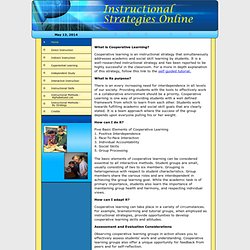
Cooperative learning is an instructional strategy that simultaneously addresses academic and social skill learning by students. It is a well-researched instructional strategy and has been reported to be highly successful in the classroom. For a more in depth explanation of this strategy, follow this link to the self-guided tutorial. What is its purpose? There is an every increasing need for interdependence in all levels of our society. Related Links - LDSE. The Learning Design Grid. Homepage - Cloudworks. Design for Learning. The vision for the Design for Learning Programme, was to bring the technical development and the effective practice strands of JISC e-Learning Programme together, ensuring that the conceptual and practical implementation of ‘design for learning’ is informed by what is known about effective pedagogic practice.
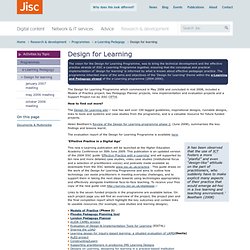
The programme inherited many of the aims and objectives of the ‘Design for Learning’ theme within the e-Learning and Pedagogy strand1 of the e-Learning programme (2004-2006). The Design for Learning Programme which commenced in May 2006 and concluded in mid 2008, included a Models of Practice project, two Pedagogy Planner projects, nine implementation and evaluation projects and a Support Project run by JISC CETIS. How to find out more? The Design for Learning wiki2 now has well over 100 tagged guidelines, inspirational designs, runnable designs, links to tools and systems and case studies from the programme, and is a valuable resource for future funded projects. Phoebe — pedagogic planner. Universal Design for Learning Series. About UDL. A short video by CAST illustrates the three principles of Universal Design for Learning.
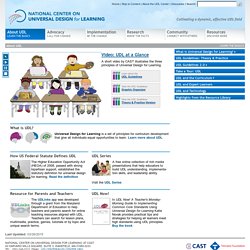
How US Federal Statute Defines UDL The Higher Education Opportunity Act (HEOA) of 2008, passed with strong bipartisan support, established the statutory definition for universal design for learning. Read the definition UDL Series A free online collection of rich media presentations that help educators to build UDL understanding, implementa-tion skills, and leadership ability. Visit the UDL Series Resource for Parents and Teachers The UDLinks app was developed through a grant from the Maryland Department of Education to help teachers and parents search for online teaching resources aligned with UDL.
UDL Now! About UDL. Cooperative Learning. Infographic - implementing e-learning for training organisations. A business case is key to sustaining e-learning (Callan and Bowman, 2010), especially as a large barrier to implementing e-learning is financial (FLAG, 2013).
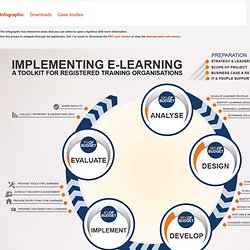
For our eight projects, the allocation of resources and development of a strong business case was an early indicator of success. The return of investment (ROI) varied across projects. Some saw a direct savings in printing costs, teaching hours, more efficient administration or communication. For others, there wasn't an easily quantifiable ROI, as the benefits were long term, like increased engagement, increased enrolments, increased retention and internal capability building.
Innovative use of new technology can result from financial drivers. The Tasmanian project is an example of technology enabled delivery that would have been cost prohibitive using other methods. UX Crash Course: 31 Fundamentals. My New Year’s Resolution for 2014 was to get more people started in User Experience (UX) Design.
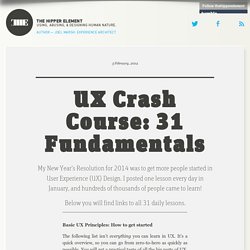
I posted one lesson every day in January, and hundreds of thousands of people came to learn! Below you will find links to all 31 daily lessons. Basic UX Principles: How to get started The following list isn’t everything you can learn in UX. It’s a quick overview, so you can go from zero-to-hero as quickly as possible. Introduction & Key Ideas #01 — What is UX? #02 — User Goals & Business Goals #03 — The 5 Main Ingredients of UX.